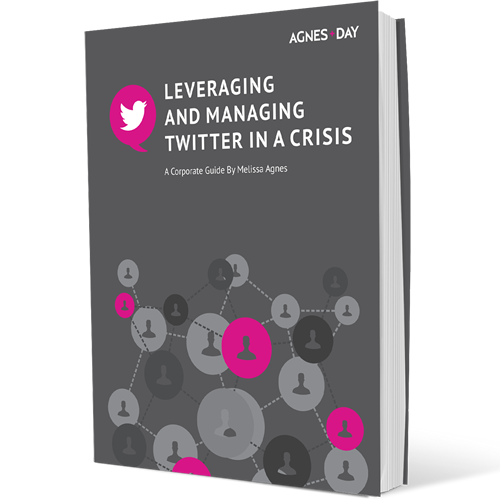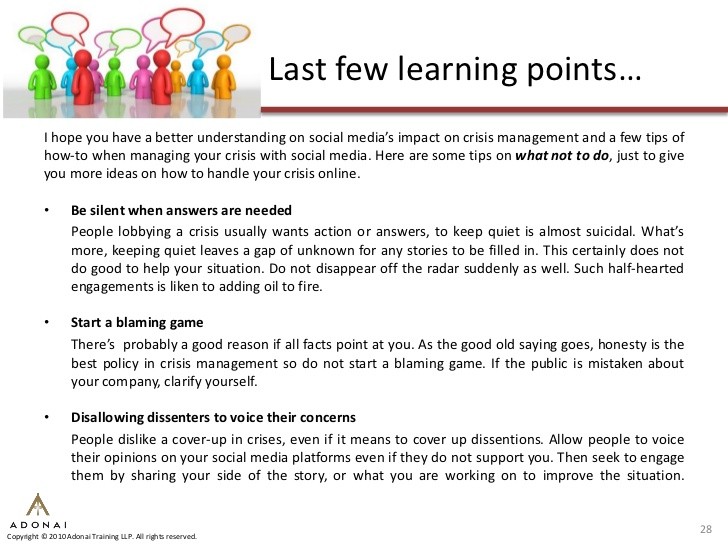13 Tips for Effective Crisis Management
Post on: 16 Март, 2015 No Comment

Dallas Lawrence
For a communicator to handle a crisis effectively, he or she needs to be looking around the corner to see what a companys potential threats and crises are, and have infrastructure set up in advance. So said Dallas Lawrence, chief global digital strategist for Burson-Marsteller, at PR News One-Day Bootcamp for Emerging PR Stars in Hollywood, Fla. held on Monday, March 18.
Lawrence provided 13 lessons for crisis preparation and management.
Lesson 1: Know and engage key conversations drivers early and often. Twitter is a conversation tool and not just a one-way medium. In times of crisis, we need to think about the key influencers following the issue and engage with them to get them information as well, Lawrence said.
Lesson 2. Actively monitor not just your reputation, but also the activities of your protagonists.
Lesson 3: Develop clear, effective and platform appropriate messaging. I n other words, be where your crisis is happening. If your crisis is happening on YouTube, make your response a YouTube video, Lawrence said. Have the capability to shoot that video. If its Friday at 5:00 and you need to shoot a video of your CEO, do you know the logistics of being able to do that?
Lesson 4: Own your brand in social before someone else does. Less than one-half of the Interbrand Top 100 Companies have registered their brands on Pinterest.
Lesson 5: Leverage the power of Twitter. Forty-six percent of journalists use twitter for sources, Lawrence said.
I routinely track down potential interviews by sending out a tweet. Most recently, we came across a number of Toyota car owners who fell under the recent recalls. Chris OConell, ABC News anchor/reporter
Lesson 6: People want to hear from people, not logos. Figure out right now who is going to be communicating for you in a crisis, and make your Twitter picture something other than just your logo in order to humanize your brand, Lawrence said.
Lesson 7: Integration is key. Video is incredibly powerful, but its useless if you dont share it in a variety of ways with your audiences, Lawrence said. This isnt Kevin Costner in Field of DreamsIf you build it, they will not just come.

Lesson 8. Be sure you know what youre talking about during a crisis. The only thing worse than saying nothing is saying the wrong thing, Lawrence said. Yes, you must move quickly during a time of crisis, but that doesnt give you a reprieve from fact-checking anything you plan to tell the public.
Lesson 9: When you blow it, own up to it: When Ashton Kutcher tweeted his outrage after Joe Paterno got fired, he had to admit that he really knew nothing about the subject. Lawrence said that, while that was an avoidable scenario, Kutcher did properly tweet afterwards, As of immediately I will stop tweeting until I find a way to properly manage this feed. I feel awful about this error. Wont happen again.
Lesson 10. Consider humor. If your product is killing people or animals are washing up on shore humor might not be right, but if its an embarrassing moment for an individual, it could be, Lawrence said.
Lesson 11: Integrate paid and earned. Paid does have a role if its integrated and used effectively, Lawrence said. With Twitter, when an earned media story is won and you want to increase its visibility, its an extremely effective way to amplify your messaging.
Lesson 12: Have clear employee rules and train for social engagement. Make sure they know the rules of the road so they dont make the kinds of mistakes weve all seen before, Lawrence said.
Lesson 13: Dont forget your secret weapon. Your employees can be your most powerful allies online, if you engage and arm them in time. Who has the biggest investment in the survival of a company? The people who get a paycheck. Lawrence said.














